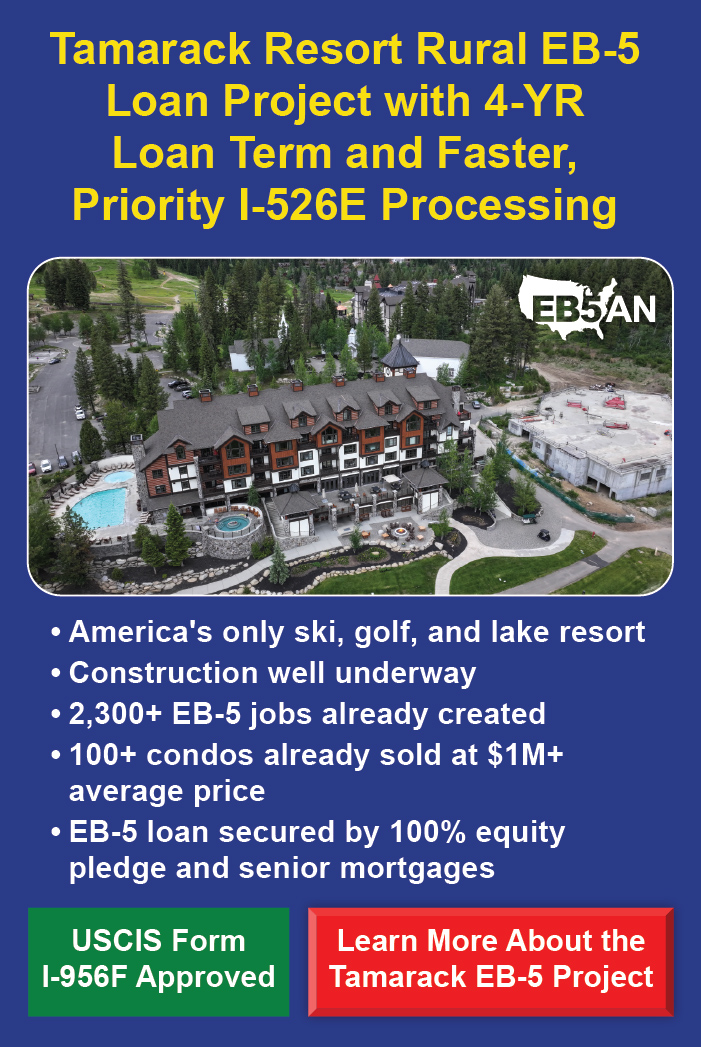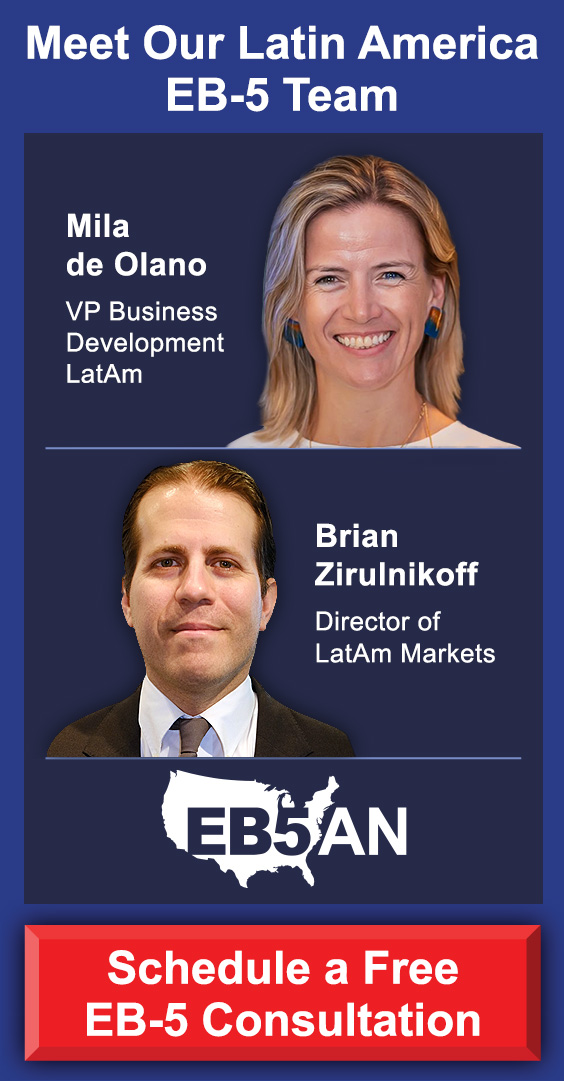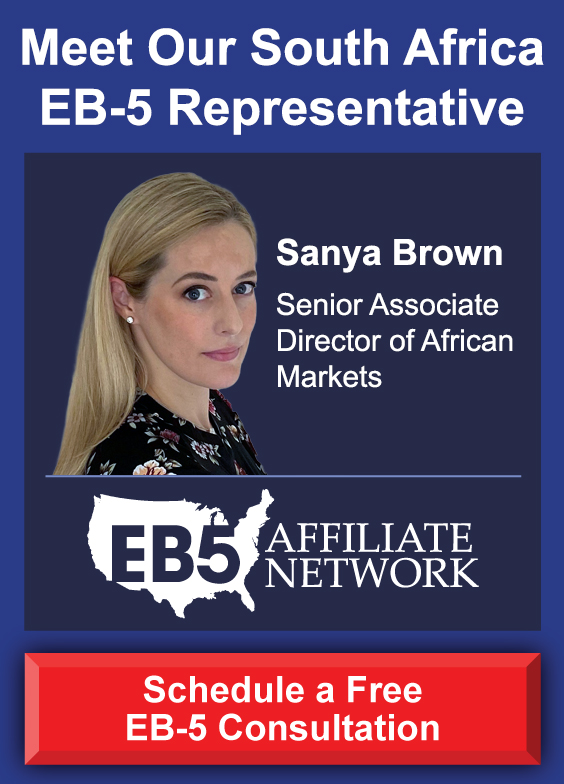The EB-5 investor visa is one of the most direct paths to a U.S. green card for yourself and your immediate, dependent family members. With straightforward requirements and several new immigration benefits, the process of getting an EB-5 green card is now more accessible and faster than ever before.
Having said this, investing in an EB-5 project involves two distinct layers of risk: immigration and financial risk.
Immigration risk…
Simply making an EB-5 investment does not guarantee that you and your family will get U.S. green cards. Rather, USCIS requires that your EB-5 funding is used to create at least 10 new jobs. This is the main requirement to immigrate through the EB-5 Program.
Financial risk…
USCIS does not allow EB-5 investors to be guaranteed a repayment of their invested funds. Rather, EB-5 investors must be open to both financial gains and losses. This is known as the “at-risk” requirement.
These two risk factors mean that both your immigration and financial interests hang in the balance when you make any EB-5 investment.
While these two types of risk exist it does not mean that you are expected to invest in a risky EB-5 project. In fact, through careful research, you can minimize your immigration and financial risk by finding an EB-5 project where the risk has been largely mitigated.
There are EB-5 projects available that are at an advanced development stage, with many EB-5 jobs already created and businesses that run in line with proven, profitable business models.
Since 2013, EB5AN has helped more than 2,300 investors from across the globe through the EB-5 regional center investment process. Our priority is to help investors make informed decisions that will protect both their immigration and financial interests.
We’ve developed a straightforward list of six key questions to ask when evaluating an EB-5 project. These are the most important factors that determine an EB-5 project’s level of risk.
We recommend that you create a set of written answers to the following questions. Once you have these answers ready, you will be in an excellent position to compare different EB-5 projects and make informed investment decisions.
We’ll show you the best—and worst—answers to each question to help you determine which EB-5 project has higher chances of success.
Here are the questions that we will cover:
1. Has the Project Created All the Required Jobs for its EB-5 Investors?
2. Does the Regional Center Have a Solid Track Record?
3. Does the Project Developer Have a Solid Track Record and a Strong Financial Standing?
4. Does the EB-5 Project Share its Financial Statements?
5. Does the Project Have an EB-5 Repayment Guaranty?
6. Are There Conflicts of Interest Between the EB-5 Regional Center and the Project Entity?
Common Red Flags to Avoid
Maximizing Your Chances of Financial and Immigration Success
1. Has the Project Created All the Required Jobs for its EB-5 Investors?
As mentioned above, job creation is the key requirement for an EB-5 green card.
In most EB-5 projects, job creation is not calculated based on the project’s actual number of employees. Rather, econometric modeling is used to calculate job creation based on a project’s construction spending or revenue creation.
Each $1 million of construction costs or $1 million of revenue creation counts toward a project’s number of EB-5-eligible jobs.
It is safer to choose an EB-5 project that will mostly create jobs through construction spending, and not revenue creation. Future revenues may be significantly lower than initially projected in a project’s business plan. Further, it may take many years for certain real estate asset types to start generating revenue.
This job calculation method makes it very risky for EB-5 investors to choose projects that are still in the early stages of construction. Most likely, these projects have not yet had significant construction spending or revenue creation.
Of course, EB-5 projects that have not started construction at all are even riskier.
The best approach is to invest in an EB-5 project that has already created, or is well on its way to create, all the required jobs for its EB-5 investors, and is expected to create in excess of the minimum required jobs for its EB-5 investors once complete.
An EB-5 project’s previous construction spending or revenues—before you have made your investment in it— can still count toward fulfilling your job creation quota. Therefore, EB-5 projects that are well under construction are generally safer options.
One such EB-5 project is EB5AN’s Twin Lakes Georgia opportunity. With over 1,800 jobs already created, you can be assured that you will be able to meet your job creation criteria.
Best Answer
The EB-5 project has created all the required jobs for all of its EB-5 investors and construction is well underway.
Worst Answer
The EB-5 project has not yet started construction or it’s still in the early stages. It has not created enough EB-5-eligible jobs through construction spending or revenue. The project plans on creating its EB-5 jobs through future revenue.
2. Does the Regional Center Have a Solid Track Record?
Regional centers play a key role in raising EB-5 capital and administering the flow of funds into EB-5 projects.
As U.S. Citizenship and Immigration Services (USCIS) licensed entities, regional centers use their EB-5 investors’ funds to purchase equity in an EB-5 project or make a loan to the project. In this way, the investors’ funds can be used by the project for job creation.
Since regional centers play a key role in managing EB-5 funding, it’s crucial to choose an approved, USCIS-compliant regional center.
First, you need to make sure that the regional center you’ll be investing in is approved by USCIS and continues to maintain its authorized status.
Then, look at their track record of prior EB-5 projects. The best regional center operators have been active in the EB-5 industry for several years and have sponsored a number of projects.
Have all of the regional center’s prior projects obtained USCIS approval? Have they all created the required jobs for their EB-5 investors?
Have EB-5 investors who have invested in these projects obtained their I-526 approval post-adjudication by USCIS? (Form I-526/I-526E is the initial application for a temporary EB-5 green card. The conditions on an EB-5 investor’s green card are later removed through Form I-829—if the investor created at least 10 jobs.)
While a history of I-526 approval is important, the most experienced and reliable regional centers have also obtained approvals for Form I-829.
Regional centers with I-829 approvals have demonstrated their ability to help investors get permanent U.S. green cards.
You should also consider the types of projects the regional center has sponsored in the past.
Were these projects developed by the same company as the project you plan to invest in? Are they in the same asset class (single-family homes, condominiums, etc.)?
If the regional center’s past successful projects are similar to the one they are currently offering, this increases your chances of success.
Learn more about EB-5 regional centers.
Best Answer
- The regional center provides a copy of its USCIS approval letter, evidence of its Form I-956 amendment filing, and proof that it remains in good standing with USCIS.
- The regional center has a history of several USCIS-approved EB-5 projects. Investors in these projects have obtained both I-526 and I-829 approval. All the regional center’s previous projects created the required jobs for their EB-5 investors.
- The regional center’s previous successful projects are nearly identical (same developer and asset class) to the project they are currently offering.
Worst Answer
- The regional center will not provide written proof that it is licensed by USCIS, proof that it has submitted an I-956 amendment filing, and remains in good standing.
- The regional center has a limited track record with few—or no— previous EB-5 projects.
- The regional center may have a history of previous projects, but these were denied by USCIS and its EB-5 investors were denied one or more I-526/I-526E or I-829 approvals. These projects failed to create enough jobs for all of their EB-5 investors.
3. Does the Project Developer Have a Solid Track Record and a Strong Financial Standing?
The project developer is responsible for bringing the EB-5 project to completion and documenting EB-5-eligible job creation and the flow of funds. The financial outcome of the project will ultimately determine whether you get your invested funds back.
Therefore, it’s essential to choose a project developer with a track record of successful projects.
Look for a developer with several completed EB-5 projects that created all the necessary jobs and succeeded financially. Of course, all of a developer’s past EB-5 projects should have obtained USCIS approval and I-526/I-526E/I-829 approvals.
Don’t only consider a developer’s past EB-5 projects. Find out whether the developer has previously completed non-EB-5 projects over a span of several years.
In fact, the best developers don’t raise EB-5 funding for all their projects; only a small number of their projects should involve EB-5 capital. The best EB-5 projects are not reliant on any EB-5 capital – the project is already fully funded, and EB-5 capital is used to reduce or replace more expensive funding such as bridge financing or senior debt.
This indicates that the developer isn’t reliant on alternative forms of funding to raise EB-5 capital and is creditworthy enough to secure financing from traditional sources.
Has the developer successfully completed several projects in the same asset class they are now offering you (single-family housing, condominiums, etc.)?
Has the developer recently been able to secure new financing or loans for its projects?
Has the developer ever defaulted on a loan or failed to complete a project? This is an important red flag.
Is the project already fully funded, and not reliant on EB-5 capital and/or won’t be affected in the event of a shortfall in EB-5 capital.
The larger and more diversified a developer’s project portfolio, the better. A developer with a wide variety of projects in various locations will have the resources to adapt to market changes and make sure each project is completed.
For further guidance, read “How to Choose a Reliable EB-5 Project Developer.”
Kolter, in partnership with EB5AN, has successfully managed and concluded several EB-5 projects. With an outstanding reputation and as the winner of numerous awards, you can rest assured knowing that your investment funds into their latest project, the Twin Lakes Georgia EB-5 project, is an excellent opportunity.
Best Answer
- The developer has been active for many years, with a large, diverse portfolio across the United States.
- While most of the developer’s projects do not require EB-5 funding, it has a track record of several USCIS-approved and completed EB-5 projects.
- The developer has never failed to repay a loan or complete a project—EB-5 or otherwise.
- It has already successfully completed several nearly identical projects to the EB-5 project that is now available.
Worst Answer
- The developer has a history of few or no completed previous projects—or their project portfolio is small and concentrated on a single asset class or geographic area.
- This is the developer’s first EB-5 project. The developer has repeatedly failed to complete projects and repay its loans.
- If the developer has previous EB-5 projects, these have failed to get USCIS approval and I-526/I-829 approvals.
- The developer may also be raising EB-5 funding for all or most of its EB-5 projects, having failed to secure traditional funding.
- The developer has never completed a project in the same asset class they are now offering.
4. Does the EB-5 Project Share its Financial Statements?
It’s essential to examine each EB-5 project’s financial statements. If a project refuses to share its financial statements, this can be a red flag. It may indicate little to no revenue, a significant amount of debt, or substantial losses.
Always insist on seeing the financial statements before investing in an EB-5 project. This includes the financial statements of the guarantor company committed to repaying the EB-5 funds loaned to the project (see point 5 below).
The two most important financial statements for EB-5 investors are the balance sheet and the income statement.
The balance sheet will show the project company’s (and, if applicable, the repayment guarantor company’s) assets, liabilities, and equity. Equity is the company’s value when you subtract its liabilities from its assets.
The income statement shows the company’s revenue, expenses, and resulting operating profit (or loss).
Read our comprehensive guide on analyzing an EB-5 project’s financial statements.
Best Answer
- The EB-5 project is willing to share its financial statements.
- The balance sheet shows that both the EB-5 project and the guarantor company have significant equity. The guarantor company’s equity is far larger than the amount of the EB-5 loan, which ensures that they will be able to repay the loan if necessary.
- The income statement shows that the project is already spending money, but that its income exceeds the costs. Ideally, the project is already profitable and generating revenue.
Worst Answer
- The EB-5 project refuses to share its financial statements. If it does share its financial statements, the balance sheet shows that the EB-5 project’s (and/or the guarantor company’s) liabilities exceed its assets. The project may have very little equity—far less than the amount of the EB-5 loan.
- The income statement shows few expenses. Since job creation is calculated based on construction spending, this can be a major risk factor for the project’s EB-5 investors.
- In addition, the project has little to no revenue even though it is already in the later stages of development. Early-stage projects will understandably have little to no revenue.
5. Does the Project Have an EB-5 Repayment Guaranty?
When a new commercial enterprise, or ‘EB-5 Investment Fund’ (the entity receiving the EB-5 capital) loans the EB-5 funds to a project company, or ‘EB-5 Project Developer’ (the entity that owns and develops the project), the EB-5 investment fund may obtain a repayment guaranty from a related company controlled by the EB-5 Project Developer that is benefiting from the EB-5 loan. This means that the company that provides the repayment guaranty—the guarantor—promises to repay the EB-5 loan by using its assets if the EB-5 Project Developer defaults on their EB-5 loan.
When structured correctly, a repayment guarantee significantly increases the financial security of the investment for EB-5 investors. Even if the EB-5 Project Developer fails to repay the EB-5 loan, a separate guarantor will then be obligated to repay the EB-5 Investment Fund.
However, for a repayment guaranty to truly have value, the guarantor must be well-capitalized and be 100% independent from the EB-5 Investment Fund. Its assets and net equity should be significantly more than the value of the EB-5 loan (as disclosed in the financial statements).
Learn more about how EB-5 repayment guaranties work.
Best Answer
- The EB-5 Investment Fund has secured a repayment guaranty with an independent, third-party guarantor and grants you access to the guarantor’s financial statements.
- The guarantor’s assets and net equity far exceed the value of the EB-5 loan. The guarantor has a proven track record and has successfully raised financing from institutional lenders. It has never failed to repay its loans.
- The more substantial and diversified the guarantor’s assets are, the better.
- The guarantor is independent of the EB-5 regional center and the EB-5 Investment Fund, with no common ownership or control.
Worst Answer
6. Are There Conflicts of Interest Between the EB-5 Regional Center and the Project Entity?
Any affiliations between the EB-5 regional center and the project developer increase investor risk. If the project encounters financial setbacks, the regional center may then fail to protect its EB-5 investors due to the conflict of interest. The investors will be less likely to get a timely repayment of their invested funds.
For example, suppose that an EB-5 project is developing an apartment building. The project has, besides the EB-5 funding it has raised, also secured a senior loan from a bank.
Rental revenues turn out to be significantly less than projected, and the project is unable to repay the senior loan.
In this case, the project developer is affiliated with the regional center and/or the EB-5 investment fund. This allows the developer to delay the repayment of the EB-5 investors’ funds or relegate investors to a lower priority tier in the project’s capital structure—either of which can be disastrous for EB-5 investors.
Learn more about identifying regional center-developer conflicts of interest.
Best Answer
The EB-5 offering documents disclose no financial relationship, joint ownership, or other form of affiliation between the project developer and the regional center.
Worst Answer
The regional center and EB-5 project developer are affiliated. They may even share the same name. The developer owns all or part of the regional center, or there is a financial relationship between both entities.
Any conflict of interest should be disclosed in writing in the project’s offering documents.
Common Red Flags to Avoid
Your investment in EB-5 is a significant one. For many EB-5 investors, this investment is the sum of their life savings, sale of property, or their inheritance. For this reason, it is essential to make sure that you invest in a solid EB-5 investment option.
Here is a summary of what you should look out for when selecting an investment project:
| The Red Flag | What To Consider |
|---|---|
| Unwilling to share financials | The EB-5 Project Developer is willing to share their balance sheet, which guarantees the repayment of EB-5 funds. This is usually because the EB-5 investment is unsecured with “no collateral” or the company itself does not actually exist. A company that is not willing to share an executed senior loan agreement or other financial commitment documents, perhaps because they do not exist, should be avoided at all costs. |
| Promises of guaranteed investment returns | Be cautious of projects that promise guaranteed or overly high returns on your investment. Guarantees such as these are likely to contradict the “at-risk” requirement of the EB-5 program. |
| Unrealistic job creation promises | If the job creation plan seems unrealistic or lacks details, it could raise concerns about the project’s ability to meet EB-5 job creation requirements. |
| Pressure to invest quickly | High-pressure sales tactics or a rushed decision-making process can indicate an attempt to prevent thorough due diligence. |
| Unsolicited investment offers | Be cautious if you receive unsolicited investment offers via email, phone calls, or other forms of communication. |
| Unverifiable claims | If the EB-5 Project Developer’s claims about its track record, partners, or success cannot be independently verified, proceed with caution. |
| Lack of legal representation | An investment opportunity that discourages or dismisses the idea of seeking independent legal advice may be problematic. |
| A vague business plan | A poorly defined or incomplete business plan without a clear path to success is a potential red flag. |
| Unrealistic time frames | If the EB-5 Project Company or EB-5 Investment Fund manager promises extremely quick processing times or completion, it may not be feasible or legitimate. |
| Difficulty communicating | If you encounter difficulty reaching project representatives or receive vague answers to your questions, it’s a warning sign. |
| Negative reputation | Research online for any negative reviews, complaints, or legal issues associated with the project or its developers. |
Frequently Asked Questions
How risky is EB-5?
As with any investment, EB-5 carries both benefits and risks.
There is, for example, the risk of losing the capital that you have invested. If the EB-5 Project Company does not perform well or encounters any challenges, your investment could be at risk.
The EB-5 program also requires that your investment creates and sustains at least 10 jobs for U.S. workers. If the job creation targets are not met within the specified time frame, your conditional green card could be at risk.
There have been instances of fraudulent schemes targeting EB-5 investors, so make sure that you work with a reputable and approved regional center or project to avoid becoming a victim of an EB-5 scam.
Lastly, consider the time frame of your investment and your potential exit strategy. Some EB-5 projects have longer investment goals, in which case you should be prepared for your capital to be tied up for the duration of the project.
Can your EB-5 Visa be rejected?
Yes, an EB-5 visa application can be rejected.
Just like any other immigration or visa application, the U.S. government has the authority to deny an EB-5 visa application if you do not meet the eligibility criteria or if there are concerns related to your application, the source of funds, the investment project, or other factors.
You may be denied your EB-5 visa if you:
- Make an investment that does not meet the EB-5 requirements.
- Provide insufficient or inaccurate documentation during your application.
- USCIS finds that the project you invested in is not viable.
- You have a criminal history.
- You have previously violated immigration laws in the U.S.
It’s important to thoroughly prepare and submit a complete and accurate EB-5 visa application that includes all the required documentation. Seeking guidance from experienced immigration attorneys, such as those at EB5AN who specialize in the EB-5 program, can greatly improve your chances of a successful application.
In the event of a denial, there may be options to appeal or reapply with corrected information. You can speak to us at EB5AN to understand what your rights and options are.
How long does the EB-5 process take?
The EB-5 process can vary in duration as it’s based on a few considerations. These include the specific steps involved, the regional center’s project timeline, USCIS processing times, and individual circumstances.
Generally speaking, the EB-5 process consists of the following main stages, each of which can impact the overall timeline:
- Choosing a project and preparing documentation
This stage involves researching and selecting an EB-5 project, preparing the necessary documentation, and ensuring compliance with the program’s requirements. This phase’s timeline depends on your ability to select a viable EB-5 project, as well as how well-organized the project is in terms of providing the correct documentation.
- I-526E petition processing
After you have invested the required capital and submitted Form I-526E (Immigrant Petition by Regional Center Investor), processing times for this petition can vary. USCIS provides estimated processing times on their website, which can range from several months to years
- Conditional permanent residency
Once the I-526E petition has been approved, if you already reside in the U.S., you can adjust your status to conditional permanent residency (Form I-485), if eligible. If you are outside the U.S., you will need to attend an immigrant visa interview at a U.S. consulate. This process can also vary in duration.
- EB-5 investment and job creation
According to USCIS policy guidance issued on October 11, 2023, the EB-5 funds must remain invested “for not less than two years” and until all the required jobs are created.
- I-829 petition processing
Within the last 90 days of your two-year conditional permanent residency period, you must file Form I-829 to remove the conditions on your permanent residency. Processing times for this petition can also vary, from several months to years, and are listed on the USCIS website.
- Obtaining permanent residency
After the I-829 petition has been approved, you will become a lawful permanent resident (green card holder) without conditions.
Maximizing Your Chances of Financial and Immigration Success
While there are many factors to consider when evaluating an EB-5 project, getting written answers to the six questions we raised in this article will provide you with a good understanding of each EB-5 project’s risk profile.
While you won’t be able to completely eliminate all the risks, you can significantly increase your chances of financial and immigration success. Through careful research, you can get U.S. green cards for yourself and your family—and also get a timely return on your invested capital.
EB5AN is an experienced EB-5 fund manager and immigration attorney. Our team has the knowledge and experience required to help you achieve both your immigration and investment goals.
We offer a free consultation to all our clients to help them understand how to proceed with their EB-5 visa application. Why not book yours here and now?







